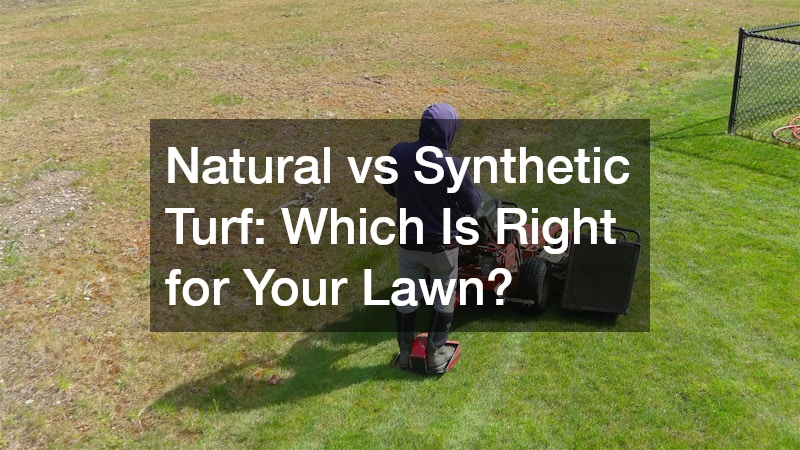Choosing the right turf for your lawn is a major decision that affects your outdoor space’s appearance, maintenance needs and long-term costs. Both natural and synthetic turf have their advantages depending on your lifestyle, climate and how you use your yard.
With Australia’s varying weather conditions and growing interest in sustainable landscaping, homeowners are weighing the benefits of each option more than ever.
Understanding the differences between natural and synthetic turf can help you make an informed choice that suits your home, budget and garden goals.
The Appeal of Natural Turf
Natural turf provides a classic, lush look and feel that many homeowners love. Real grass improves air quality, reduces heat and supports biodiversity in your garden. It is often cooler underfoot during hot Australian summers, making it more comfortable for pets and children to play on.
Caring for natural turf involves regular mowing, watering, fertilising and occasional aerating or weeding. While this maintenance takes time and effort, some people enjoy the gardening process and find it rewarding. The scent of freshly cut grass and the seasonal changes it goes through can also add to the charm of having a living lawn.
Natural turf can be particularly beneficial in cooler, wetter climates where grass thrives more easily without heavy irrigation.
Why Homeowners Choose Synthetic Turf
Synthetic turf has gained popularity as a low-maintenance alternative to natural grass. Made from durable materials like polyethylene or polypropylene, it stays green year-round with little effort. For people with busy lifestyles or those living in areas with strict water restrictions, synthetic turf offers a convenient solution.
It does not require mowing, watering or fertiliser, which means lower ongoing costs and less time spent on upkeep. Synthetic turf is also highly durable and resistant to wear from kids, pets and foot traffic, making it ideal for high-use areas or rental properties.
Modern synthetic turf looks more realistic than ever and comes in different colours, textures and pile heights to match your preferences.
Environmental Considerations
Natural turf contributes to environmental health by absorbing carbon dioxide, producing oxygen and filtering rainwater. It also supports soil health and can provide a habitat for insects and small animals. However, maintaining a lawn can use a lot of water, especially in drier parts of Australia, and overuse of fertilisers or pesticides can harm local ecosystems.
Synthetic turf eliminates the need for watering and chemicals, which helps conserve resources and reduce runoff pollution. On the other hand, it is made from plastic materials and eventually needs to be disposed of, which raises concerns about landfill waste.
The environmental impact of turf depends on how it is used and maintained. Choosing eco-friendly practices for either option can reduce your footprint.
Cost Comparison
Initial installation costs for natural turf are generally lower than for synthetic turf. However, natural grass has ongoing costs such as water bills, fertilisers, mowing equipment and maintenance services. Over time, these costs can add up significantly depending on lawn size and local climate.
Synthetic turf has a higher upfront cost but fewer expenses down the track. Once installed, the only regular maintenance may involve brushing or hosing down the surface to keep it clean. Many homeowners find that synthetic turf pays for itself over the years through savings in time and utilities.
Consider how long you plan to stay in your home and what level of effort you are willing to put into lawn care when comparing the financial investment.
Comfort and Safety
Both natural and synthetic turf offer safe surfaces for children and pets, but they feel different underfoot. Natural turf provides a soft, cool base that cushions falls and reduces heat. However, it can become muddy after rain and may attract insects or allergens during certain seasons.
Synthetic turf is consistently clean and usable in all weather conditions, making it ideal for play areas and entertaining. Some types of synthetic turf can get hot in direct sunlight, so it may not be as comfortable during peak summer heat unless cooling features are added or the area is shaded.
Advancements in synthetic turf design have led to improved drainage and UV protection, increasing comfort and usability for Australian homes.
Which One Is Right for You?
Choosing between natural and synthetic turf comes down to your specific needs and preferences. If you enjoy gardening, have time for maintenance and live in an area with sufficient rainfall, natural turf may be a better option. It offers a living landscape that feels connected to nature and changes with the seasons.
If you want a green lawn all year with minimal effort, synthetic turf is a practical and visually appealing alternative. It suits busy households, drought-prone regions and spaces where durability and cleanliness are priorities.
You may even consider combining both types — for example, using natural turf in the front yard and synthetic turf in high-traffic or shaded backyard areas.
When it comes to choosing the right turf, there is no one-size-fits-all answer. Natural turf brings the charm of a living lawn and environmental benefits, while synthetic turf offers convenience, durability and year-round visual appeal.
Understanding how each type fits with your lifestyle, local climate and design preferences will help you create an outdoor space that looks great and works for your everyday life. Whether you go natural or synthetic, the right turf can transform your lawn into a space you enjoy year-round.



